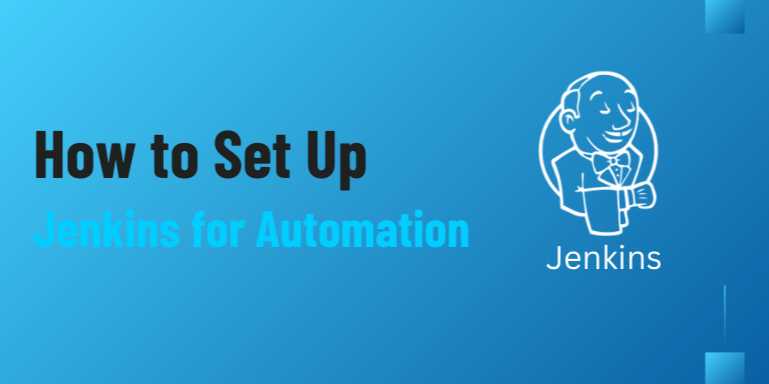How to Set Up Jenkins for Automation: A Complete Beginner’s Guide to CI/CD

📘 Chapter 5: Advanced Automation with Jenkins
🔐 Introduction
After learning how to create pipelines and run basic jobs,
it’s time to unlock Jenkins’ full potential for advanced automation.
Jenkins is more than just a build tool — it’s a powerful orchestration platform
for CI/CD pipelines, infrastructure provisioning, containerization, cloud
integrations, and much more.
This chapter dives into how Jenkins can power complex,
enterprise-level workflows through advanced scripting, integrations, and
best practices. Whether you're running multi-cloud deployments, managing
microservices, or handling infrastructure as code, Jenkins can automate it all.
🚀 Advanced Jenkins Use
Cases
|
Use Case |
Description |
|
Multi-environment
deployment |
Automate deployments
to dev, staging, and production |
|
Docker image creation & publishing |
CI/CD for
containerized applications |
|
Kubernetes
orchestration |
Use Jenkins with
kubectl or Helm for K8s deployments |
|
Infrastructure as Code |
Run
Terraform, Ansible, or Pulumi from pipelines |
|
Microservices
orchestration |
Build and deploy
multiple services independently |
|
Scheduled and triggered automation |
Create
nightly builds, backups, or trigger chains |
🧰 1. Using Jenkins with
Docker
✅ Building Docker Images in
Pipelines
groovy
pipeline
{
agent any
stages {
stage('Build Docker Image') {
steps {
script {
docker.build('my-image:latest')
}
}
}
stage('Push to Docker Hub') {
steps {
withCredentials([usernamePassword(credentialsId: 'docker-creds',
usernameVariable: 'USER', passwordVariable: 'PASS')]) {
sh """
echo $PASS | docker login -u $USER
--password-stdin
docker push my-image:latest
"""
}
}
}
}
}
✅ Docker-Based Agents
Use Jenkins agents within containers for isolated
builds:
groovy
pipeline
{
agent {
docker {
image 'node:18'
args '-v /tmp:/tmp'
}
}
stages {
stage('Run') {
steps {
sh 'npm install && npm test'
}
}
}
}
☁️ 2. Jenkins and Cloud Integrations
✅ AWS with Jenkins
|
Task |
How to Automate It |
|
Deploy to EC2 |
Use SSH + shell script
or Ansible |
|
S3 Upload |
Use AWS CLI
in pipeline |
|
EKS Deployments |
Use kubectl and Helm |
|
Credentials |
Use Jenkins
AWS Credentials Plugin |
✅ Azure and GCP Support
- Install
the Azure CLI plugin or Google Cloud SDK
- Use
credentials binding for service accounts
- Deploy
to App Service, VMs, or Cloud Run
Example: Deploy Static Site to S3
groovy
pipeline
{
agent any
environment {
AWS_ACCESS_KEY_ID =
credentials('aws-access')
AWS_SECRET_ACCESS_KEY =
credentials('aws-secret')
}
stages {
stage('Deploy to S3') {
steps {
sh 'aws s3 sync ./site/ s3://mybucket/
--delete'
}
}
}
}
🧱 3. Infrastructure as
Code (IaC)
✅ Terraform with Jenkins
|
Step |
Shell Command in
Jenkins |
|
Initialize |
terraform init |
|
Plan Changes |
terraform
plan -out=tfplan |
|
Apply Changes |
terraform apply tfplan |
Use Terraform CLI in a Docker agent or install
locally on Jenkins nodes.
✅ Ansible Automation
You can use Ansible for server provisioning:
groovy
pipeline
{
agent any
stages {
stage('Provision Servers') {
steps {
sh 'ansible-playbook -i inventory.ini
playbook.yml'
}
}
}
}
⚙️ 4. Using Parameters for
Dynamic Jobs
✅ Parameterized Builds
Enable user input during runtime:
|
Parameter Type |
Usage |
|
String Parameter |
Custom message or tag |
|
Choice Parameter |
Select from
predefined values |
|
Boolean Parameter |
Toggle flags (e.g.,
run tests: true/false) |
|
File Parameter |
Upload file
to job |
Declarative Example:
groovy
parameters
{
string(name: 'ENV', defaultValue: 'dev',
description: 'Target Environment')
booleanParam(name: 'RUN_TESTS', defaultValue:
true, description: 'Run Tests?')
}
🧪 5. Parallel and Matrix
Builds
✅ Parallel Stages
Speed up pipelines by running tasks simultaneously:
groovy
stages
{
stage('Test') {
parallel {
stage('Unit Tests') {
steps { sh 'npm test' }
}
stage('Lint') {
steps { sh 'npm run lint' }
}
}
}
}
✅ Matrix Builds (e.g.,
Cross-platform Testing)
groovy
matrix
{
axes {
axis {
name 'OS'
values 'ubuntu', 'windows'
}
axis {
name 'NODE'
values '14', '16', '18'
}
}
stages {
stage('Test') {
steps {
echo "Running on OS=${OS} with
Node.js ${NODE}"
}
}
}
}
🔐 6. Managing Secrets
Securely
Use Jenkins Credentials Manager:
- Store
passwords, API tokens, SSH keys, AWS credentials
- Inject
into environments using withCredentials
Example:
groovy
withCredentials([string(credentialsId:
'slack-webhook', variable: 'HOOK')]) {
sh "curl -X POST -d 'Build complete'
$HOOK"
}
📊 7. Logging, Monitoring,
and Alerts
✅ Post Actions
groovy
post
{
always {
echo 'Build finished.'
}
success {
echo 'Build succeeded!'
}
failure {
echo 'Build failed!'
}
}
✅ Notification Tools
|
Tool |
Function |
|
Email Ext |
Send email alerts |
|
Slack Plugin |
Notify team
in Slack |
|
Discord Webhooks |
Integrate build alerts
in Discord |
🧠 8. Scaling Jenkins with
Agents
✅ Why Use Agents?
- Free
up master resources
- Run
multiple builds in parallel
- Build
for different environments (Linux, Windows, Mac)
✅ Agent Types
|
Agent Type |
Description |
|
Static Agent |
Manually configured
remote machine |
|
SSH Agent |
Use SSH to
connect remote node |
|
Docker Agent |
Spin containers
dynamically |
|
Kubernetes Agent |
Use ephemeral
pods via Jenkins K8s plugin |
📘 Summary
Jenkins isn’t just for simple CI/CD — it’s a DevOps
powerhouse capable of automating complex pipelines, provisioning
infrastructure, and orchestrating containerized and cloud-native applications.
By using advanced features like parameterized jobs, Docker builds, IaC
integrations, and parallel testing, your team can scale both quality and
speed.
With advanced automation, Jenkins goes from being a build
tool to becoming your infrastructure and deployment command center.
FAQs
1. What is Jenkins and why is it used in automation?
Jenkins is an open-source automation server that helps developers automate building, testing, and deploying code. It enables Continuous Integration and Continuous Delivery (CI/CD), making software delivery faster and more reliable.
2. What are the system requirements to install Jenkins?
To install Jenkins, you need:
- Java
11 or later (Java 17 recommended)
- At
least 2 GB of RAM and 1 GB of disk space
- A
modern browser for accessing the Jenkins UI
3. What’s the easiest way to install Jenkins for beginners?
The simplest way is to use the Jenkins WAR file:
java -jar jenkins.war
Alternatively, you can use a Docker container for a quick and clean setup:
docker
run -p 8080:8080 jenkins/jenkins:lts
4. How do I connect Jenkins to my GitHub repository?
Install the Git and GitHub plugins, then:
- Create
a new job or pipeline
- Choose
“Git” as the source code management
- Enter
the GitHub repo URL and credentials if needed
- Add
a webhook to trigger Jenkins builds on each push
5. What is a Jenkins Pipeline?
A pipeline is a script-based workflow written in Groovy DSL that defines your automation steps (e.g., build, test, deploy). Pipelines can be declarative (simplified) or scripted (flexible).
6. What plugins should I install first in Jenkins?
For basic automation, start with:
- Git
plugin (source control)
- Pipeline
plugin (workflow scripting)
- Docker
plugin (if using containers)
- Blue
Ocean (modern UI for pipelines)
- Email
Extension (build notifications)
7. Can Jenkins be used with Docker and Kubernetes?
Yes! Jenkins integrates with Docker for building images and with Kubernetes for scaling jobs using agents. Tools like Jenkins X also help automate deployments in Kubernetes.
8. How do I secure my Jenkins installation?
- Use
HTTPS for the web UI
- Create
individual user accounts
- Configure
role-based access controls
- Mask
secrets and tokens in logs
- Regularly
update plugins and Jenkins core
9. How do I trigger Jenkins builds automatically?
You can:
- Use webhooks
from GitHub/GitLab
- Schedule
jobs using CRON syntax
- Trigger
builds after another job completes
- Use
a poll SCM trigger to check for changes periodically
10. Is Jenkins free to use for commercial projects?
Yes! Jenkins is 100% free and open-source, licensed under MIT. You can use it in personal, educational, and commercial environments without restriction.
Tutorials are for educational purposes only, with no guarantees of comprehensiveness or error-free content; TuteeHUB disclaims liability for outcomes from reliance on the materials, recommending verification with official sources for critical applications.
Explore Other Libraries
Please allow ads on our site
Kindly log in to use this feature. We’ll take you to the login page automatically.
Login
Join Our Community Today
Ready to take your education and career to the next level? Register today and join our growing community of learners and professionals.

Your experience on this site will be improved by allowing cookies. Read Cookie Policy
Your experience on this site will be improved by allowing cookies. Read Cookie Policy

Comments(0)